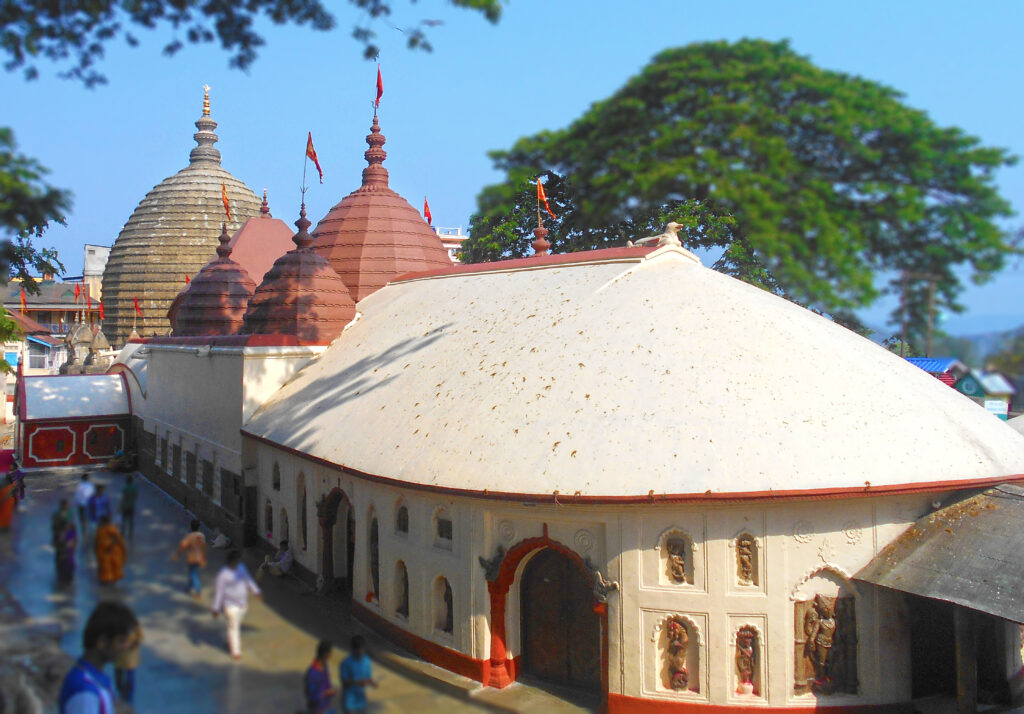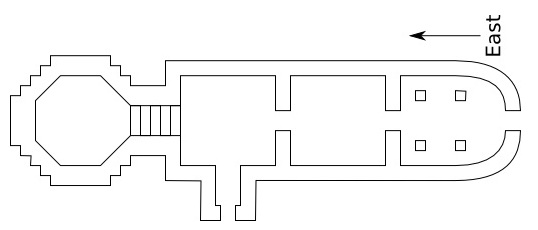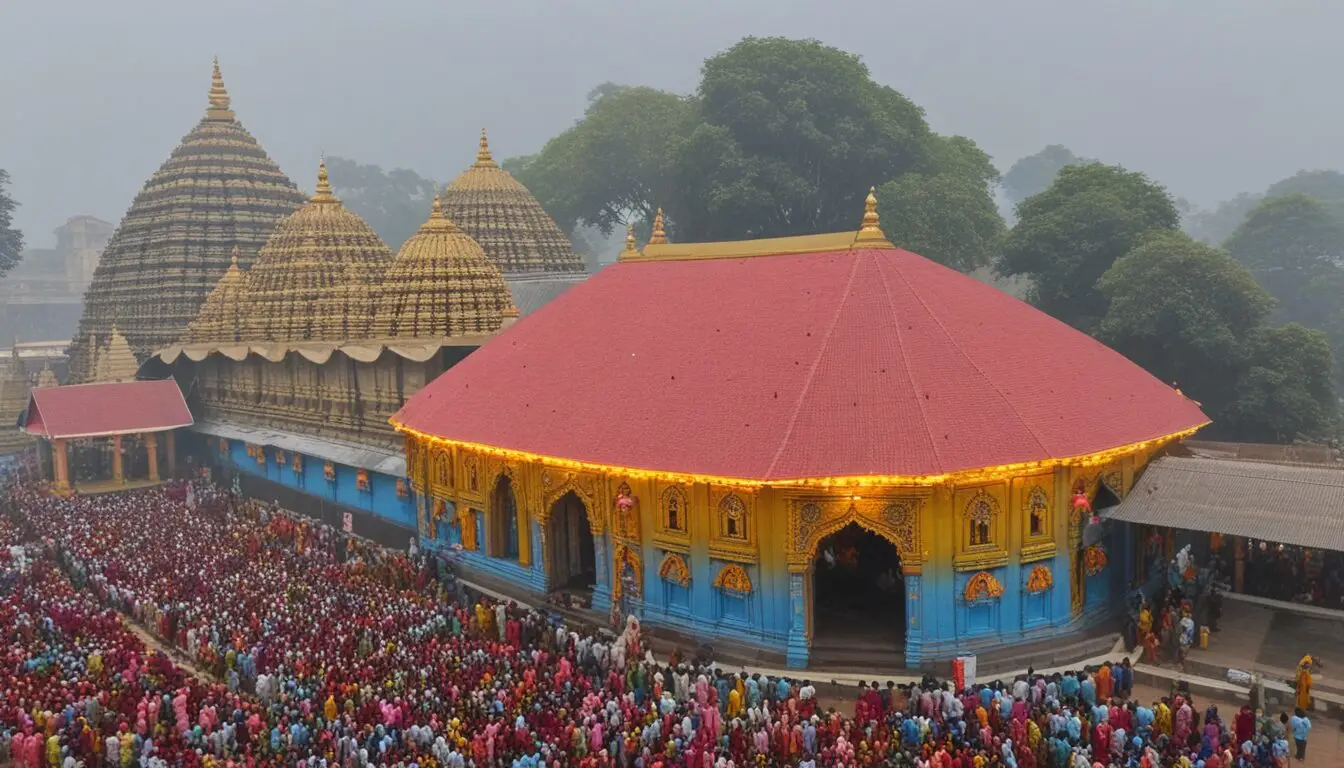
Priest’s Note: This teaching belongs to our Kamakhya GuidePedia. Seek more wisdom in the sacred navigation [🕉️ Kamakhya Temple GuidePedia Navigation 🕉️] below ↓↓↓↓.
Perched atop Nilachal Hill in Guwahati, Assam, the Kamakhya Temple is more than just a sacred shrine—it’s a journey into the heart of Tantra, divine femininity, and an architectural style that defies convention. As one of the most revered Shakti Peethas, Kamakhya offers a powerful blend of spiritual energy, ritual practice, and unique design, making it a must-visit for seekers, scholars, and travelers alike.
🛕 Unmistakable Form: The Nilachal Style of Architecture
Rebuilt in the 16th century by the Koch dynasty, Kamakhya Temple gave rise to the Nilachal architectural style—a fusion of local craftsmanship and Mughal influences rarely seen elsewhere in India.
🔍 Key Architectural Features:
- Bulbous dome resting on a cruciform base
- Sixteen-sided polygonal tower adorned with horizontal moldings
- Angashikaras (mini spires) reminiscent of minarets
- Brick-and-stone construction reflecting a mix of Assamese and Islamic techniques
🏗️ Architectural Trivia:
Unable to replicate the original stone shikhara, Koch architects turned to Islamic dome-building methods—accidentally creating a new hybrid form that now defines Nilachal architecture.

🗺️ Spatial Design: Five Chambers, Five Journeys
Kamakhya Temple’s plan is remarkably articulated, with five distinct chambers that guide devotees from darkness to divine light.
| Section | Purpose | Roof Style |
|---|---|---|
| Garbhagriha | Inner sanctum | Hemispherical dome |
| Antarala | Transitional vestibule | Tiered, thatch-style |
| Jagamohana | Congregation hall | Vaulted rectangular roof |
| Bhogmandir | Offering chamber | Five-domed Pancharatna style |
| Natmandir | Dance/performance hall | Shell-shaped vaulted ceiling |
Each zone mirrors a metaphysical path—from inner divinity to outer expression.

Kamakhya Temple Base plan By Chaipau – Wikipedia.
🔺 Sacred Symbolism: The Power of the Yoni
Unlike most temples with idols, Kamakhya centers on a yoni-shaped rock fissure—eternally moist from a subterranean spring—symbolizing Devi Kamakhya herself.
💫 Why the Yoni Matters:
- Embodiment of Shakti (divine feminine energy)
- Symbol of creation, fertility, and cosmic power
- Marks the legendary site where Sati’s womb fell, per the Puranas
🩸 Highlight: Ambubachi Mela (June)
The goddess is believed to undergo her annual menstruation. The temple closes for three days, then reopens to massive celebrations—honoring the sanctity of the female body.
🎨 Materiality & Motifs: Stone, Brick, and Living Myth
Kamakhya’s visual language is layered with spiritual and natural themes.
✨ Notable Features:
- Grey stone walls juxtaposed with red brick domes
- Carvings of goddesses, floral vines, and mother-child scenes
- Daily ritual offerings to a vermillion-smeared Ganesha near the entry
This contrast of color and texture speaks to Assam’s natural resources and artisan traditions.
🕉️ Tantra & Mahavidyas: A Living Tantric Center
Kamakhya is the epicenter of Tantric worship in India—open to both right-hand (dakshinachara) and left-hand (vamachara) paths.
🔥 Esoteric Symbolism:
- Surrounded by 10 shrines dedicated to the Mahavidyas (e.g., Kali, Tara, Bhairavi)
- Erotic carvings subtly express divine union and primal energy
- Red vermilion signifies blood, fertility, and life force
🐐 Traditional Practices:
Animal sacrifices (goats, pigeons) are still performed—rooted in tribal Shakti cults that predate Vedic orthodoxy.
🌅 Everyday Devotion: Life at the Temple
Kamakhya Temple is not frozen in time—it pulses with ritual rhythms and devotee devotion.
🌼 What You’ll See:
- Morning aartis with conch shells, bells, and incense
- Sadhus and Tantrics draped in saffron and ash
- Sacrificial rituals outside the eastern gate
- Seasonal processions and spiritual congregations, especially during festivals
👣 Visiting Tips:
👟🚫 Remove shoes and headwear.
⚠️👗 Dress modestly (salwar-kameez, kurta-dhoti).
📸🚫 Photography is not allowed in the sanctum.
⚠️👩 Traditionally, menstruating women do not enter
🎉 Festivals that Shape Kamakhya’s Spirit
| Festival | Season | Key Features |
|---|---|---|
| Ambubachi Mela | Mid-June | Celebrates goddess’s menstruation, temple closure |
| Durga Puja | September–October | Floral décor, regional rituals, cultural events |
| Kali Puja | October–November | Midnight offerings, lamps, Tantric ceremonies |
🕊️ Best Time to Visit:
October to March (cooler weather) or during festivals for a deeper cultural dive—though expect crowds.
🕔 Pro Tip:
Arrive early (around 5:00 AM) to witness morning rituals in peaceful silence before the rush.
💬 Final Reflections: A Temple Like No Other
Kamakhya Temple is not just a monument—it’s a living altar of the Goddess, where architecture, nature, myth, and Tantra converge. Whether you’re drawn by spiritual devotion, esoteric curiosity, or artistic appreciation, Kamakhya offers an experience that transcends time.
Sources: Temple texts, architectural analysis, and verified records from Wikipedia, KamakhyaDevi.org, kamakhya.org, and ShreeKamakhya.com.
🙋 Have You Been to Kamakhya?
What resonated with you—the architecture, the rituals, or the symbolism? Share your thoughts or questions in the comments below.
🌿 Expand Your Journey: Nearby Places Worth Exploring
Enhance your visit with spiritual and scenic detours around Kamakhya Hill.
🌄 Top Attractions Near Kamakhya Temple:
- Umananda Island – The world’s smallest inhabited river island
→ Guide to Umananda Island - Basistha Ashram – A forest hermitage tied to sage Vasistha
→ Read: Journey to Basistha Ashram - Assam State Museum – Explore Assam’s layered past
→ Fascinating Guides of the Assam Museum
🏨 Need a place to stay? Explore:
🕉️ Kamakhya Temple GuidePedia Navigation 🕉️
Your complete guide to the sacred temple
🛕 Temple Guide 🛕
🏛️ Attractions 🏛️
🏨 Accommodation 🏨
🍽️ Food & Dining 🍽️
✨ Spiritual Secrets ✨
🚗 Guwahati → 5 Gems 🚗
🙏 Explore the divine journey through Kamakhya Temple 🙏



